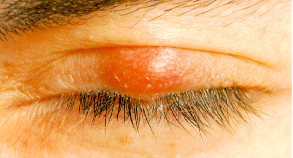Chalazion


What is a Chalazion?
The term chalazion (pronounced kah-la’-ze-on) comes from a Greek word meaning a small lump. It refers to a swelling in the eyelid caused by chronic or acute inflammation of one of the small oil producing glands (meibomian glands) located in the upper and lower eyelids.
A chalazion is similar to a stye which also appears as a lump in the eyelid. A stye is an acute inflammatory infection of a lash follicle and forms a red, sore lump near the edge of the eyelid. A chalazion is usually a reaction to trapped oil secretions and not caused by bacteria, although the site often becomes secondarily infected by bacteria. Chalazions tend to occur farther from the edge of the eyelid than styes (although a gradual swelling can be felt near the edge of the lid), and tend to “point” toward the inside or nose side of the eyelid. Sometimes, a chalazion can cause the entire eyelid to swell suddenly.
How Common are Chalazion?
Chalazion are very common. There are over 200,000 Chalazion treated in the USA each year.
How is a Chalazion Treated?
When a chalazion is small and without symptoms, it may disappear on its own. Usually, however they don’t disappear without treatment. If the chalazion is large, it may cause blurred vision by distorting the shape of the eye and certainly becomes more cosmetically noticeable.
Chalazions may be treated with any one or a combination of the following methods:
There is generally no role for Antibiotic and/or steroid drops, antibiotic and/or steroid pills as the Chalazion is not an infection.
Warm Compresses
The first stage of treatment is warm compresses;
Warm compresses can be applied in a variety of ways. The simplest way is to hold a clean washcloth, soaked in hot water, against the closed lid for five to ten minutes, three to four times a day. Repeatedly soak the washcloth in hot water to maintain adequate heat;
Massage or expression of the glandular secretions with the washcloth;
Warm compresses generally result in resolution of the chalazion 50% of the time
Injection of steroids
The second option is an injection of steroids to resolve the chalazion. Generally Kenalog (40 mg/ml) .2 cc is injected adjacent to the chalazion. This can cause depigmentation of the skin or a white deposit that may take months to resolve. This treatment for chalazia results in resolution about 75% of the time.
Surgical incision or excision
[ninja-popup id=1493]
The third option and the most definitive is surgical incision and curretage. This results in resolution about 95% of the time. Often small chalazia are difficult to localize especially if not marked prior to injection of the local anesthetic. The procedure is generally done in office but in children or non cooperative patients or those with communicable diseases, it can be done in an ambulatory surgery center or hospital operating room.
Chalazions usually respond well to treatment, although some people, particularly children, are prone to recurrences and may require continuing medication. If a chalazion recurs in the same place, Dr Malitz may suggest a biopsy to rule out more serious problems such as sebaceous carcinoma. Dr. Malitz has found success in recommending cranberry juice on a regular basis orally to prevent recurrences. It is not clear how cranberry juice works but likely it changes the secretions and has a prophylactic effect.
